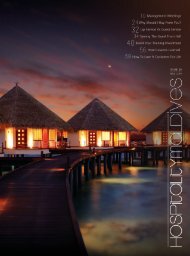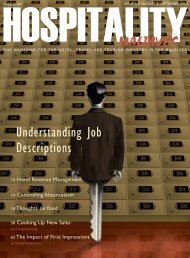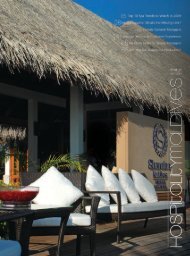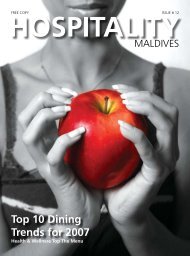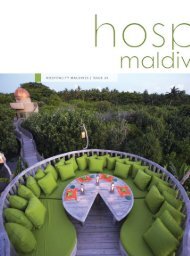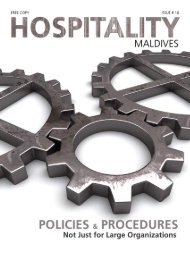Don't Let Your Systems Drive Your Customers Crazy! - Hospitality ...
Don't Let Your Systems Drive Your Customers Crazy! - Hospitality ...
Don't Let Your Systems Drive Your Customers Crazy! - Hospitality ...
You also want an ePaper? Increase the reach of your titles
YUMPU automatically turns print PDFs into web optimized ePapers that Google loves.
ENVIRONMENT<br />
A<br />
property with 350 guest rooms can spend $300,000 per<br />
year on electricity, $50,000 on natural gas, and another<br />
$60,000 annually on water and sewer. Most properties<br />
have the potential to significantly reduce energy and water consumption<br />
without any impact on guest comfort. Simple management<br />
strategies like the ones presented here can reduce your<br />
utility bills by 30 percent or more while helping your facility<br />
become a better steward of the environment.<br />
Every watt of electricity that your property uses generates<br />
air pollution and hazardous waste. Every gallon of water<br />
depletes fresh water resources and generates waste water.<br />
On the other hand, every watt of electricity or gallon<br />
of water conserved saves money and conserves natural resources.<br />
The checklists below identify cost-effective activities that<br />
also conserve resources. If your property is not already conducting<br />
these activities, plan to incorporate them into your<br />
operations in the near future.<br />
In facilities management, conserving resources and saving money<br />
often go hand-in-hand. The following examples illustrate typical<br />
cost savings.<br />
●<br />
●<br />
●<br />
Switching from an incandescent to a compact fluorescent<br />
lamp can save over $50 per year.<br />
Replacing older, water-wasting showerheads with low-flow<br />
models can save over $3,600 per year.<br />
Installing low-flush toilet devices in older toilets can save<br />
over $5,800 per year.<br />
LIGHTING<br />
Lighting accounts for 30 - 40 percent of commercial electricity<br />
consumption.<br />
Lighting energy demand can be reduced through a combination<br />
of common sense conservation measures and use of energy-efficient<br />
lamps and fixtures, such as those described below.<br />
● Fluorescent Lamps. Use energy-conserving compact<br />
fluorescent lamps (CFLs) instead of incandescent lamps for<br />
general lighting that stays lit more than four hours per day.<br />
●<br />
Lighted Exit Signs. Use low-wattage lamps in exit signs<br />
instead of the more common incandescent lamps. Lightemitting<br />
diodes (LEDs) are the most energyefficient option,<br />
but CFLs are still an improvement over incandescent lamps.<br />
Although LEDs can cost over 50 percent more than low-wattage<br />
incandescent lamps, the payback period is less than one year and<br />
they last 10 times as long.<br />
The biggest savings come from annual energy costs: LEDs cost<br />
85 percent less to operate than incandescent lamps.<br />
● Motion Sensors or Timers. Install motion sensors or timers<br />
in meeting/conference rooms, linen closets, pantries, freezer<br />
units/storage areas and as outdoor lights; such lights can be<br />
set to go off after five to seven minutes of inactivity. Some<br />
ECO•LODGE•ICAL facilities have saved over 45 percent<br />
on annual energy costs using sensors in meetings rooms and<br />
storage areas.<br />
●<br />
●<br />
Task Lighting. In common areas, direct lighting on areas that<br />
need greater illumination to avoid over-lighting whole area.<br />
For additional information on lamps and fixtures, including<br />
product-specific recommendations, contact the following<br />
organizations:<br />
EPA’s Energy Star Program has technologyspecific fact<br />
sheets, case studies, and analytical and financial tools. Call<br />
(202) 775-6650 or (800) STAR-YES or visit www.energystar.<br />
gov.<br />
“ Some ECO•LODGE•ICAL<br />
facilities have saved over 45<br />
percent on annual energy costs<br />
using sensors in meetings rooms<br />
and storage areas. ”<br />
●<br />
●<br />
The National Lighting Product Information Program<br />
publishes technical reports and independent performance<br />
tests of brand name lighting products. To purchase these<br />
publications, fax the Lighting Research Center at (518) 276-<br />
2999 or visit www.lrc.rpi.edu.<br />
The Electric Power Research Institute (EPRI) also offers<br />
technology-specific reports. To order, call the EPRI<br />
Publications Distribution Center at (510) 934-4212 or visit<br />
www.epri.com.<br />
HOSPITALITY MALDIVES OCTOBER/NOVEMBER 2006 1



